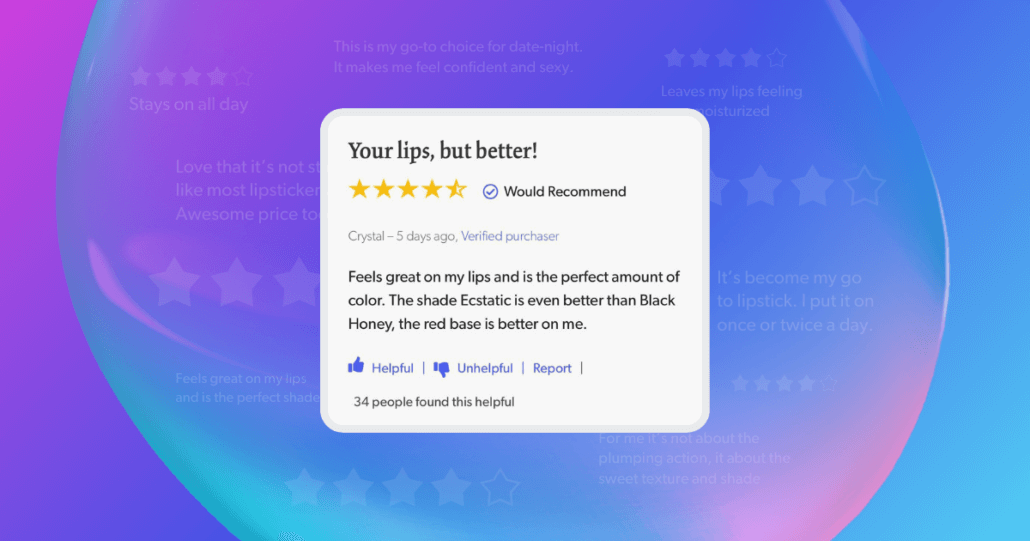July 21, 2023
How and why AI-powered voice assistants can unlock new growth for your e-commerce brand.
In 2023, AI assistants are everywhere — they’re completing your sentences, managing your projects, scheduling your meetings, and making your playlists. But what if we told you an AI assistant could do your makeup for you?
In January, Estée Lauder launched VMA, or voice-enabled makeup assistant, that does just that. VMA uses both face scanning and voice commands to help visually impaired customers apply the right shades of foundation, mascara, and blush to their faces. It’s just one of the many ways voice-enabled AI will shape the future of the customer experience, improving not only business outcomes but also painting a bright picture of inclusivity and accessibility.
Voice commerce, or v-commerce, will become an increasingly important element of e-commerce in the years to come. As people become accustomed to conversational commerce from the comfort of their own homes and mobile phones, voice assistants will play a bigger role in how they interact with brands.
Brands will benefit from learning how to harness the power of v-commerce. Here’s how AI-powered voice assistants such as Siri and Alexa can go above and beyond for you.
What is voice commerce?
Voice commerce is a type of e-commerce experience that allows customers to buy products and services using voice commands. Designed by online retailers to work with voice assistants such as Apple’s Siri, Amazon’s Alexa, and Microsoft’s Cortana, voice commerce reduces friction in the customer journey and tailors the buying experience to each person who uses it.
Voice-enabled commerce is a relatively new technology, but thanks to recent leaps in artificial intelligence development, it’s quickly advancing in functionality and popularity.
In terms of practical use, voice commerce is especially well-suited for industries such as beauty, apparel, packaged goods, consumer electronics, and home improvement because of the huge number of content and products available. With voice commerce, you can discover products, look at pricing, and make purchases without manually typing in requests via search engines.
Hey Alexa, how does voice commerce work?
Voice commerce works at various stages of the customer journey in online shopping — from product discovery and checkout to customer service and support.
The tech used in voice commerce deploys voice recognition and natural language processing (NLP) software to interpret voice commands and respond accordingly. Newer voice commerce models implement advanced AI and machine learning to adjust responses based on the user’s preferences, sizing, previous purchases, and location.
Whether the customer wants to compare prices for certain products, learn about different models, or add an item to a cart, voice-activated digital assistants can carry out the request in real time.
For instance, say you’re in the market for a new coffee maker. Whether you’re at home or on the go, you can ask your smart device questions or issue commands such as:
Hey Google, what’s the difference between a Chemex and an Aeropress?
Hey Siri, how much does a Chemex cost?
Alexa, I’d like to order a Chemex on Amazon.
Alexa, what’s my order status for the Chemex?
As a consumer, it’s easy to see why online shopping with voice commands is convenient. It’s as easy as asking a friend to pick something up at the store.
For online stores, implementing voice commerce is one step closer to a complete omnichannel customer experience. You can reach your ideal customer where they are, when they need you. You’ll also reduce steps in the buying process — no need to attract customers to your site, direct them through multiple landing pages, and have them manually enter payment info.
Benefits of voice commerce for customers and sellers
Voice commerce is an emerging channel that will develop as new technologies advance. Some of the current and future benefits of voice commerce for consumers are:
- Hands-free convenience. No need to log into accounts, type in search queries, or sift through endless ads
- Frictionless online payments. With payment info stored in smart devices, customers don’t have to manually enter credit card info
- Personalized shopping experiences. Voice assistants collect and process data from previous purchases so that every interaction is personalized for repeat customers
- Knowledgeable voice assistants. Generative AI assistants are getting smarter by the day, harnessing the world’s knowledge and sharing it with users
Business owners will see impactful benefits as well, such as:
- Increased customer satisfaction. With voice assistants that “know” their wants and needs, deployed by brands they trust, voice commerce will make the customer experience more empathetic and human (plus, voice assistants can easily collect feedback about how to improve customer service)
- Reduced support costs. Much like Questions & Answers, voice assistants can also deliver operational cost savings by reducing the volume of requests to your support team. Customers communicate in their preferred way, and get the answers they need without needing to call your support line
With the assistance of generative AI models such as ChatGPT, voice assistants will only become more valuable as functionality increases. Voice commerce models will not only be able to respond more accurately to user questions and commands, but they will also be able to predict user needs and prompt them to take specific actions.
Ok Google: What does voice commerce sound like in 2023?
There’s never been a better time to get started with voice commerce. Here’s a few facts and figures about the current state of voice commerce within the overall e-commerce landscape:
- 20% of Google searches are voice searches
- 62% of smart speaker users say they’ll probably use their speakers to make a purchase in the upcoming month
- The smart speaker market is expected to exceed $30 billion by 2024
- As of May 2022, 54% of U.S. consumers are using voice-activated search for retail
- Voice assistants on the market will increase to 8 billion by 2023 (up from 2.5 billion in 2018)
- The estimated value of voice commerce transactions in 2023 is $19.4 billion (up from just $4.6 billion in 2021)
With online shopping reaching new peaks every year and the use of generative AI becoming widespread, businesses can take advantage of these new technological advances to reach new audiences.
V commerce best practices
The tech behind voice commerce may be advanced, but getting started with it isn’t as complex as it sounds.
- Do SEO for voice search. Yes, many voice commerce systems are directly linked to search engines like Google. Items you sell via voice commerce should be linked to relevant keywords and phrases that people are likely to use when searching for products or services on voice assistants — think long-tail, full sentence keywords
- Create voice-friendly content. Write content that’s easy for voice assistants to understand and that provides the information that people are looking for. Often people engage with voice assistants conversationally, so include colloquialisms and phrases common to the spoken language
- Offer voice-activated shopping. Aka, allowing people to purchase products or services using their voice. Bonus points if you can optimize the checkout process to occur in as few steps as possible
- Provide customer support through voice assistants and/or voice-assisted chatbots. Make it possible for people to get help with their orders or questions using their voice
- Track voice commerce results. Set measurable performance indicators such as the number of voice searches, voice-activated purchases, and voice support requests that you receive. Voice commerce is only one sales channel, and the benchmarks you set for it should be aligned with your overall company goals
- Implement key findings from customer insights. Use tools such as Bazaarvoice’s Insights and Reports tool to transform user-generated reviews and answers into actionable insights for your e-commerce strategy
AI and the future of commerce
It may seem too early to depend on Google Home or Amazon Echo to bring in impactful revenue — but it’s the perfect time to experiment with the effects it can have on your customers and your business.
Consider voice commerce as a sandbox and see in what novel and interesting ways your customers will interact with your products. You might discover conversations you never thought you’d have or opportunities to improve acquisition that were sitting right under your nose. After all, robots aren’t the only ones that can listen. You can listen to them, too.
Voice commerce is just the latest trend in the AI evolution. Next learn how to leverage the innovative tech for e-commerce in our guide to AI marketing.










